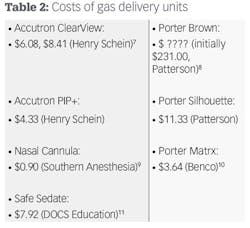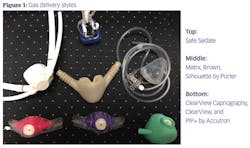Nitro-nomics: The real costs of using nitrous oxide in the dental office
Dr. Anthony Carroccia details the expenses of using nitrous oxide in the dental office and explains how to recoup some of those costs.
Nitrous oxide is dentistry's oldest drug. It has been used since December 11, 1844, when Dr. John Mankey Riggs extracted an upper wisdom tooth from Dr. Horace Wells. (1) Since then, it has been a matter of how to use it, when to use it, and how to be remunerated for its use.
The production of nitrous oxide has not changed in more than two centuries. There are numerous ways to manufacture the gas, but Sir Humphry Davy's way outlined in his Researches, chemical and philosophical, chiefly concerning nitrous oxide is still the favorite. Davy heated ammonium nitrate to produce water vapor and nitrous oxide,(2) which results in a quality product that is inexpensive to produce. So, what are the real costs of nitrous oxide/oxygen sedation to the dental practice?
There are three basic areas of expense to the dental office: transportation of tanks, the tanks themselves, and the delivery style. Wilson reports that 89% of the dental community uses nitrous oxide/oxygen sedation. (3) Dentists are being more judicious about their overhead, so it's time to reassess if what is being used is best. The gas systems themselves will not be assessed in this article. Purchasing a two- or four-yoke portable system is initially less expensive than a central system. Having copper pipes laid, which must be soldered with silver due to the market price of the metals and lengths of pipes, will always be more expensive. The gas cylinders are another matter.
We will consider the expense of transporting the tanks first, based on 2016 prices. My personal supplier is a national company, but the representative declined permission to name it directly. Prices are accurate; the company name is withheld. Readers are encouraged to pull their own invoices to check prices. Portable "E" cylinders are used on the yokes. The "G" and "H" tanks are the taller cylinders that connect into a manifold. The National Fire Protection Agency stipulates that a dental office may have at most three cylinders of each-two connected and one in reserve. (4) The flat fee for delivery is $14.25, regardless of the size ordered. The same is true for the fuel surcharge fee of $5.90. The hazmat charge is $22.
In total, the charge to have gas cylinders delivered will cost an office $42.15. There is a final charge in this category that is rarely discussed-the annual cylinder lease renewal. For G and H tanks, it is $95 per tank, resulting in an annual charge of $380 for two tanks of each gas. Consider saving another $190 by not keeping three tanks of each. All of these figures are before applicable taxes.
The cylinders of gas have their own expenses. Table 1 shows the capacity and prices for each cylinder. It also assumes the average adult respires approximately 6 L of gas for tidal volume. Another assumption has been made for simplification of the math: gases will be used in a 50/50% mixture. It is noteworthy to remember that as of June 27, 2016, the American Academy of Pediatric Dentistry now considers this percentage moderate sedation. I concur that this concentration and volume are quite high for most children. (5) The final number at the bottom of Table 1 reflects true costs of gas at 50% mixture and 6 L as the flow rate per one hour. The result is a number that is slightly overestimated.
There are many styles of delivery devices on the market today. This article includes just the ones most commonly used. Outpatient dental offices usually use these delivery styles: cannula, hoods, and a combination. Cannula are simple medical nasal cannula. The hood group includes Porter/Brown and Matrx, ClearView and PIP+ (both from Accutron). The combination group has Safe Sedate and Porter Silhouette, which incorporates both cannula and hood. Figure 1 shows many of these delivery styles. This article will not compare each delivery style or unit, although it is quite enlightening to learn that the product being used may or may not be the best one for the office. Nationally, capnography is now a requirement for moderate sedations and deeper as of October 2016. (6) However, individual state boards may vary on their requirements and/or may be in the process of changing them.
Table 2 shows the costs of these delivery units per item, not in bulk as they are sold. The initial expensive cost of the Porter/Brown mask goes down asymptotically as its use continues after autoclaving. It is the only item that is not disposable; all of the others are single-use delivery. The two Accutron ClearView prices reflect styles with and without capnography capability. The larger fee is for the unit with capnography. The costs that may be incurred to retrofit existing systems to use either cannula or combination units are not shown. Simply add the gas system in the office from Table 1 to the delivery style in Table 2 to find costs of each individual use of nitrous oxide-oxygen at the base level.
Remuneration should now be evaluated. Most practitioners would like to have another CDT code to use for additional time, similar to intravenous sedation. Such discussions indeed are warranted. Within the 37040 zip code, the usual large insurance companies A, B, C, and D pay a range of $27-$50. The amount insurance companies pay for the same procedure varies by zip code. Knowing how much is paid per procedure and checking it against the sum from the tables will show the profitability of using nitrous oxide-oxygen sedation in the practice. This does not factor in the transportation and/or retrofitting expenses.
Sedate well, and sedate safely!
References
1. Clark M, Brunick A. Handbook of Nitrous Oxide and Oxygen Sedation. 4th ed. St. Louis, MO: Elsevier; 2015.
2. Davy H. Researches, Chemical and Philosophical: Chiefly Concerning Nitrous Oxide or Diphlogisticated Nitrous Air, and Its Respiration. London: Biggs and Cottle; 1800.
3. Wilson S. A survey of the American Academy of Pediatric Dentistry membership: nitrous oxide and sedation. Pediatr Dent. 1996;18(4):287-293.
4. Malamed SF, ed. Sedation: A Guide to Patient Management. 4th ed. St. Louis, MO: Mosby; 2002.
5. Coté CJ, Wilson S. American Academy of Pediatric Dentistry. American Academy of Pediatrics. Guidelines for monitoring and management of pediatric patients before, during, and after sedation for diagnostic and therapeutic procedures: update 2016. Pediatr Dent. 2016;38(4):E13-E39.
6. American Dental Association. Guidelines for the Use of Sedation and General Anesthesia by Dentists. http://www.ada.org/~/media/ADA/Education%20and%20Careers/Files/anesthesia_use_guidelines.pdf?la=en?123. Adopted October 2016. Accessed January 5, 2017.
7. Henry Schein Dental 2016 catalog.
8. Patterson Dental 2016-2017 catalog.
9. Southern Anesthesia and Surgical Inc. website. https://www.sasrx.com/e2wNewItemSearch.aspx?q=nasal%20cannual#1. Accessed January 5, 2017.
10. Dentist's Desk Reference. 2016-2017. Benco Dental.
11. Safe Sedate N20 nasal masks. DOCS Education. https://docseducation.com/catalog/safe-sedate-n20-nasal-masks. Accessed January 5, 2017.
Anthony S. Carroccia, DDS, MAGD, ABGD, practices full-time in a private practice in Clarksville, Tennessee. A lecturer on nitrous oxide since 2010, he was dubbed "The Nitrous Guy" at an American Dental Association lecture in 2015. Dr. Carroccia is a master in the College of Sedation in Dentistry and a diplomate of the Dental Organization for Conscious Sedation. You may contact him at [email protected].



